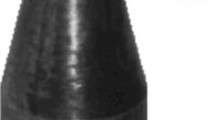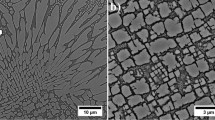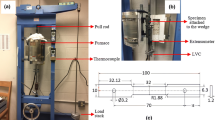Abstract
Inconel 617 is a solid-solution-strengthened Ni-based superalloy with a small amount of gamma prime (γ′) present. Here, samples are examined in the as-received condition and after creep exposure at 923 K (650 °C) for 574 hours and 45,000 hours and at 973 K (700 °C) for 4000 hours. The stress levels are intermediate (estimated, respectively, as of the order of 350, 275, and 200 MPa) and at levels of interest for the future operation of power plant. The hardness of the specimens has been measured in the gage length and the head. TEM thin foils have been obtained to quantify dislocation densities (3.5 × 1013 for the as-received, 5.0 × 1014, 5.9 × 1014, and 3.5 × 1014 lines/m2 for the creep-exposed specimens, respectively). There are no previous data in the literature for dislocation densities in this alloy after creep exposure. There is some evidence from the dislocation densities that for the creep-exposed samples, the higher hardness in the gage length in comparison with the creep test specimen head is due to work hardening rather than any other effect. Carbon replicas have been used to extract gamma prime precipitates. The morphology of γ′ precipitates in the ‘as-received’ condition was spheroidal with an average diameter of 18 nm. The morphology of these particles does not change with creep exposure but the size increases to 30 nm after 574 hours at 923 K (650 °C) but with little coarsening in 45,000 hours. At 973 K (700 °C) 4000 hours, the average gamma prime size is 32 nm. In the TEM images of the replicas, the particles overlap, and therefore, a methodology has been developed to estimate the volume fraction of gamma prime in the alloy given the carbon replica film thickness. The results are 5.8 vol pct in the as-received and then 2.9, 3.2, and 3.4 vol pct, respectively, for the creep-exposed specimens. The results are compared with predictions from thermodynamic analysis given the alloy compositions. Thermodynamic prediction shows that nitrogen content is important in determining the gamma prime volume fraction. This has not previously been identified in the literature. The higher the nitrogen content, the lower the gamma prime volume fraction. This may explain inconsistencies between previous experimental estimates of gamma prime volume fraction in the literature and the results here. The observed decrease in the γ′ volume fraction with creep exposure would correspond to an increase in TiN. At present, there are insufficient experimental data to prove that this predicted relationship occurs in practice. However, it is observed that there is a higher volume fraction of TiN precipitates in the gage length of a creep sample than in the head. This suggests that secondary TiN particles are precipitating at the expense of existing γ′ due to the ingress of N from the atmosphere, possibly via creep cracks penetrating in from the surface of the gage length. This effect is not expected to be observed in real components which are much larger and operate in different atmospheres. However, this highlights the need to be conscious of this possibility when carrying out creep testing.


















Similar content being viewed by others
References
J.C. Hosier, and D.J. Tillack: Met. Eng. Q., 1972, vol. 12 (3), pp. 51–55.
R.W. Vanstone: in Proc. 5th International Charles Parsons Turbine Conference: Parsons 2000: Advanced Materials for 21st Century Turbine and Power Plants, vol. 736, A. Strang, W.M. Banks, R.D. Conroy, G.M. McColvin, J.C. Neal, and S. Simpson, eds., IOM Communications, Ltd., London, 2000, pp. 91–97.
F. Masuyama: ISIJ Int., 2001, vol. 41(6), pp. 612–625.
R. Viswanathan, J. F. Henry, J. Tanzosh, G. Stanko, J. Shingledecker, B. Vitalis and R. Purgert: J. Mater. Eng. Perform., 2005, vol. 14(3), pp. 281-292.
S. Chomette, J.-M. Gentzbittel and B. Viguier, J. Nucl. Mater., 2010, vol. 399, pp. 266-274.
D. Kaoumi and K. Hrutkay, J. Nucl. Mater., 2014, vol. 454, pp. 265-273.
A.K. Roy, M.H. Hasan and J. Pal, Mater. Sci. Eng. A, 2009, vol. A520, pp. 184-188.
W.L. Mankins, J.C. Hosier, and T.H. Bassford: Metall. Mater. Trans. B 1974, vol. 5, pp. 2579-2590.
Y. Hosoi, and S. Abe: Metall. Trans. A 1975, vol. 6A, pp. 1171-1178.
S. Kihara, J.B. Newkirk, A. Ohtomo, Y. Saiga: Metall. Trans. A, 1980, vol. 11A, pp. 1019-1031.
R. Krishna, S.V. Hainsworth, H.V. Atkinson and A. Strang: Mater. Sci. Technol., 2010, vol. 26(7), pp. 797-802.
S. Chandra, R. Cotgrove, S.R. Holdsworth, M. Schwienheer, and M.W. Spindler: in Proc. ECCC Creep Conf. on Creep and Fracture in High Temperature Components-Design and Life Assessment Issues, I.A. Shibli, S.R. Holdsworth, and G. Merckling, eds., DEStech Publications, London, 2005, pp. 178–88.
H.-J. Penkalla, J. Wosik, E.V. Fischer, and F. Schubert: in Proc. 5th International Symposium on Superalloys 718, 625, 706, and Derivatives, E.A. Loria, ed., 17–20 June 2001, Pittburgh, Pennsylvania, pp. 279–90.
E. Gariboldi, M. Cabibbo, S. Spigarelli and D. Ripamonti: Int. J. Pressure Vessels Pip., 2008, vol. 85, pp. 63-71.
Q. Wu, H. Song, R.W. Swindeman, J.P. Shingledecker, and V.K. Vasudevan: Metall. Mater. Trans. A, 2008, vol. 39A, pp. 2569-2585.
O.F. Kimball, G.Y. Lai, and G.H. Reynolds: Metall. Mater. Trans. A, 1976, vol. 7A, pp. 1951-1952.
T. Takahashi, J. Fujiwara, T. Matsushima, M. Kiyokawa, I. Morimoto, and T. Watanabe: Trans. ISIJ, 1978, vol. 18, pp. 221–224.
H. Kirchhöfer, F. Schubert, and H. Nickel: Nucl. Technol., 1984, vol. 66(1), 139-148.
K.R. Vishwakarma, N.L. Richards and M.C. Chaturvedi: Mater. Sci. Eng. A, 2008, vol. 480(1-2), pp. 517-528.
R. Krishna, S.V. Hainsworth, S.P.A. Gill, A. Strang, and H.V. Atkinson: Metall. Mater. Trans. A, 2013, vol. 44A, pp. 1419-1429.
P.J. Ennis and W.J. Quadakkers: in Proc. 7th Int. Charles Parson Turbine Conf. on Power Generation in an Era of Climate Change, A. Strang, W.M. Banks, G.M. McColvin, J.E. Oakey, and R.W. Vanstone, eds., Institute of Materials, London, 2007, pp. 509–18.
M. Avrami: J. Chem. Phys., 1941, vol. 9(2), pp. 177–184.
W. Johnson and R. Mehl: Trans. Am. Inst. Min. Metall. Eng. 1939, vol. 135, pp. 416-458.
J.R. Yang and H.K.D.H. Bhadeshia: Weld. J. Res. Suppl., 1990, vol. 69, 305s–307s.
R. Hambleton, W.M. Rainforth and H. Jones: Philos. Mag. A, 1997, vol. 76(5), pp. 1093-1104.
R.K. Ham: Phil. Mag., 1961, vol. 6, pp. 1183-1184.
P. Hirsch, P. Howie, R.B. Nicholson, D.W. Pashley and M.J. Whelan: Electron Microscopy of Thin Crystals, Krieger, New York, N.Y. 1977.
N. Saunders, Z. Guo, X. Li, A.P. Miodownik, and J.-P. Schillé: in Superalloys 2004, K.A. Green, T.M. Pollock, and H. Harada, eds., TMS (The Minerals, Metals & Materials Society), Warrendale, PA, 2004, pp. 849–58.
Thermo-Calc Software AB (Version 4), http://www.thermocalc.com, SE-113 47: Stockholm, Sweden, August 2006.
C.P. Blankenship Jr, E. Hornbogen, and E.A. Starke Jr.: Mater. Sci. Eng. A, 1993, vol. 169A, pp. 33-41.
Inconel alloy 617 datasheet, Publication Number SMC-029, Copyright © Special Metals Corporation, 2005.
S.V. Prikhodko, H. Yang, A.J. Ardell, J.D. Carnes, and D.G. Isaak, Metall. Mater. Trans. A, 1999, vol. 30A, pp. 2403-08.
W.D. Nix and H. Gao, J. Mech. Phys. Solids, 1998, vol. 46, pp. 411–25.
U. Krupp and H.J. Christ, Metall. Mater. Trans. A, 2000, vol. 31A, pp. 47–56.
K. Yuan, R. Peng, X.H. Li, S. Johansson, and Y. Wang: MATEC Web of Conferences Vol. 14 (2014), EUROSUPERALLOYS 2014—2nd European Symposium on Superalloys and their Applications, Giens, France, May 12–16, 2014, vol. 14, 16004. doi:10.1051/matecconf/20141416004
J. Wosik, B. Dubiel, A. Kruka, H.-J. Penkalla, F. Schubert, A. Czyrska-Filemonowicz: Mater. Charact., 2001, vol. 46, pp. 119–123.
I.M. Lifshitz and V.V. Slyozov: J. Phys. Chem. Solids, 1961, vol. 19, pp. 35-50.
C. Wagner: Z. Elektrochem., 1961, vol. 65, pp. 581-591.
R. Krishna, S.V. Hainsworth, S.P.A. Gill, A. Strang, and H.V. Atkinson: in Proc. 2nd Int. ECCC Conf. on ‘Creep & Fracture in High Temperature Components—Design & Life assessment’, I.A. Shibli and S.R. Holdsworth, eds., 21–23 April 2009, Zurich, pp. 764–76.
Acknowledgments
The authors would like to thank ALSTOM Power Ltd. for supplying creep-exposed Inconel 617 alloys and wish to thank the U.K. Government’s Technology Strategy Board for providing financial support to carry out this work. Mr. G. Clark is thanked for help with microscopy and preparing samples for TEM analysis. Dr. R. Chantry is thanked for assistance with dislocation density analysis. Professor A. Strang and Dr. G. McColvin have provided valuable advice and guidance.
Author information
Authors and Affiliations
Corresponding author
Additional information
Manuscript submitted December 19, 2014.
Appendix A: Relationship Between the Projected Area Fraction of Particles Observed in the TEM Micrograph and Their Actual Volume Fraction
Appendix A: Relationship Between the Projected Area Fraction of Particles Observed in the TEM Micrograph and Their Actual Volume Fraction
The observed area fraction of particles from a TEM micrograph depends on the thickness of the film, as the images of particles at different depths can overlap, as shown in Figure 3(a). The effect of the overlap (or impingement) of particles imaged through a transparent film is very similar to those for a partially complete phase transformation. The classic Kolmogorov–Johnson–Mehl–Avrami (KJMA) equation[22,23] considers the evolution of the volume fraction \( V_{\text{f}} \) of a phase as it grows over time. Taking into account the impingement of particles, this is expressed in terms of the extended volume fraction, \( V_{\text{ext}} \), which is the volume fraction of particles that would exist in the absence of particle impingement. At any point in time, the fractional increase in the observed volume fraction, \( {\text{d}}V_{\text{f}} \), is given by the fractional increase in the extended volume fraction, \( {\text{d}}V_{\text{ext}} \), multiplied by the probability that the new volume is not already transformed, \( (1 - V_{\text{f}} ) \), such that
This is readily integrated to give the widely used relationship
For small volume fractions, the likelihood of impingement is small and the two volume fractions are approximately the same.
Now consider the projection of the three-dimensional (3D) transformed phase onto a two-dimensional (2D) plane, similar to that shown in Figure 3(a). The increase in the observed volume fraction of the phase will be associated with an increase in the observed area fraction of the phase, \( {\text{d}}A_{\text{f}} \), in this plane. Similarly, the increase in the extended volume fraction of the transformed phase will be associated with an increase in the extended area fraction, \( A_{\text{ext}} \), in this plane. As before, the increase in the observed area fraction depends on the current untransformed area fraction, \( \left( {1 - A_{\text{f}} } \right) \), such that
and hence, similar to (1), we can also write
This applies to the 2D images of particles that we see in the transparent TEM images. Note that the particles do not typically impinge within the volume of the sample itself. The impingement here is simply the overlap of particles when imaged through the thickness of the sample. Clearly, the thicker the sample, the more overlap that is expected to be observed.
Now consider the situation in Figure A1, for a number of whole or partial spherical particles of radius \( R \)in a film of thickness h. Within a central region of the sample, of thickness \( h + 2R \), the particles are necessarily whole (uncut). Near the surface, the particles are cut, and have centers that are within a distance of \( \pm R \) of the specimen surface, as shown. The average volume of a particle subject to a single random cut at any point through its diameter is \( \frac{2}{3}\pi R^{3} \), half the volume of an intact particle. The extended volume fraction of the particles is therefore
where \( N \) is the number of particles per unit volume. The extended volume fraction is independent of the sample thickness as expected. Similarly, the average cross-sectional area of a spherical particle cut on a random plane is \( \frac{2}{3}\pi R^{2} \). The projected cross-sectional area of a transparent particle is \( \frac{2}{3}\pi R^{2} \) if less than half the particle remains after the cut and \( \pi R^{2} \) if more than half remains (as the maximum cross-section is observed). As each case is equally likely, the average projected area is therefore \( \frac{5}{6}\pi R^{2} \). Thus, the total extended area fraction of the particles cross-section is[36]
Rearranging [A2] and [A4], and substituting them in [A6], we can express the actual volume fraction, \( V_{\text{f}} \), in terms of the observed area fraction in the TEM image, \( A_{\text{f}} \), as
or finally
where the exponent \( m = \frac{4R}{4R + 3h} \). This expression is plotted in Figure A2 for a range of \( m \) values. The linear relationship seen for small area fractions arises when there is negligible overlap. Note that this model is only strictly correct for \( h > 2R \). For \( h < 2R, \) there is the possibility of a particle being cut twice by the film surface, both top and bottom. Taking this into account does slightly modify the exponent \( m \), but not to such a significant extent that justifies the increase in complexity of the model.
This analysis assumes all the particles are the same size. For a distribution of particle sizes, it can be shown that \( R \)is replaced by \( \overline{{R^{3} }} /\overline{{R^{2} }} \), where \( \overline{{R^{3} }} \) is the average value of \( R^{3}, \) etc. For the Lifshitz, Slyozov, and Wagner (LSW) particle size distribution[37,38] for particles undergoing classic Ostwald ripening, the relationships between area, volume, and radius are \( \overline{{R^{2} }} = 1.046 \left( {\bar{R}} \right)^{2} \) and \( \overline{{R^{3} }} = 1.13 \left( {\bar{R}} \right)^{3} \). In this case, \( \overline{{R^{3} }} /\overline{{R^{2} }} = 1.08\bar{R} \), so the exponent will be adjusted to \( m = \frac{{4.32\bar{R}}}{{3h + 4.32\bar{R}}} \) for a typical distribution of particle sizes.
In addition, the quantity measured to characterize the particles size also needs to be considered carefully, so that what is actually measured on the micrograph is clearly interpreted. The average radius of a spherical particle of radius \( R \) cut on a random plane is \( \frac{\pi }{4}R \). As before, for transparent particles, the observed average radius is therefore \( \frac{\pi }{4}R \) if less than half the particle remains and \( R \) if more than half remains. Hence, the average observed radius for a cut particle is \( \frac{1}{2}\left( {1 + \frac{\pi }{4}} \right)R \). The average measured particle radius of all the cut and uncut particles of radius \( R \) is therefore
This shows that the average cut radius varies from \( 0.785R \le R_{\text{ext}}^{\text{TEM}} \le R \) as the film thickness goes from very small to very large. Taking the average value over a distribution of particle sizes gives \( \bar{R} = 1.12\bar{R}_{\text{ext}}^{\text{TEM}} \), where \( \bar{R}_{\text{ext}}^{\text{TEM}} \) is the average particle radius measured from the TEM micrograph.
Rights and permissions
About this article
Cite this article
Krishna, R., Atkinson, H.V., Hainsworth, S.V. et al. Gamma Prime Precipitation, Dislocation Densities, and TiN in Creep-Exposed Inconel 617 Alloy. Metall Mater Trans A 47, 178–193 (2016). https://doi.org/10.1007/s11661-015-3193-9
Published:
Issue Date:
DOI: https://doi.org/10.1007/s11661-015-3193-9






